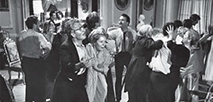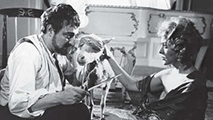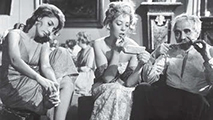

Inhibitions, Thresholds, and Loss of Virginity in Bunuel’s The Exterminating Angel: Film (1962) and Opera (2016)
Bruce H. Sklarew, Film Editor
Bruce H. Sklarew, M.D., an associate editor and co-founder of the award-winning Projections: The Journal for Movies and Mind, organizes the film programs at meetings of the American Psychoanalytic Association and has co-edited three books on psychoanalysis and film.

Bruce H. Sklarew
The Exterminating Angel is an enigma that locks the audience into a series of inexplicable events, experienced rather than explained, like the surrealistic timeless “now” of a dream. While comical and satirical on the surface, it inflicts upon the audience disturbing distortions in time and logic. The elements of irrationality—co-existing opposites, condensations, displacements and symbolizations—were adopted by the surrealists from Freud’s primary process and referred to by Bunuel as “psychic automatism.” The unconscious motivations of his characters become visible, and reveal the ambiguities and contradictions that lead to the collapse of order. This process allows “the vulgarity of man and his attitudes to erupt.” (Michel Esteve, 1963). The Exterminating Angel was based on the title for an unlaunched play by Jose Bergamin. The initial film title, The Castaways of the Calle de la Providencia, evoked a shipwreck linked to Bunuel’s lingering image of Gericault’s monumental painting in the Louvre, the Wreck of the Medusa.
A most clever and satirical filmmaker, Bunuel was born in the remote village of Calanda, Spain, in 1900. In Paris, among the surrealists he made two avant-garde and masterful films with Dali, Un Chien Andalou and L’Age d’Or. Fleeing from Franco’s Fascist regime, he worked in Hollywood and New York, where he was fired from the Museum of Modern Art for his communist leanings. The Exterminating Angel was made in 1962 with full freedom at the end of his 18 years in Mexico. He completed his career in Paris in the ‘60s and ‘70s with two of his films involving rituals of unfulfilled dinner parties to mock the bourgeoisie.
Following a performance of Donizetti’s Lucia di Lammermoor, the film depicts an elegant dinner party in Mexico City. In the opening sequences, the expected order is interrupted when servants suddenly decide to take a walk to leave the mansion, and events repeat themselves: the guests entering, the servants leaving, and the toast and introductions during the dinner party. Much of the initial dialogue is in non sequiturs, replies are incongruous and illogical, and affect is inappropriate. This bizarre dialogue subverts the mannered conversations of the bourgeoisie and presages the shattering of their defenses, unleashing hallucinations, delusions and magical thinking along with the primary process.

The 20 upper class aristocrats and professionals then retire to a salon. When they attempt to leave, they inexplicably will not pass through a large open doorway. They endure a collective inhibition about leaving as opposed to the servant’s collective impulse to desert the mansion as if it were a sinking ship. Bunuel casts a “spell,” an inchoate mysterious force which constrains the will of the guests and inhibits relatives, friends, police and even a boy from entering the house (His seductive caretaker priest says, “Never trust a child.”) They suffer an inability to satisfy their needs for food, water and freedom.
Bunuel implies that the inhibition is an internalization of the oppressive burdens and rituals of the authoritarian social-political order, the systems of the church, state and military. He mocks the upper class by entrapping them in the epitome of their social fabric, an elaborate dinner party. They suffer hunger, desperation, terror and death and are given license to a cauldron of instincts. Assaults, suicides, seductions, affairs, incestuous overtures and murderous wishes follow. They futilely attempt a pastiche of religious rituals from the Kabbalah, comical Masonic codes, and the idea of “a washable rubber virgin” to release the inhibiting force. The departure of the servants contributes to the group’s regression through an absence of caretaking and nurturance and the desperation of abandonment.

Bunuel connects death with the film’s bourgeoisie; a conductor dies, an engaged couple commits suicide, and one of the guests delights in describing a fatal train wreck. They wonder if everyone outside is dead as no one enters to save them. A number of men want to kill Nobile, the host, because they fantasize he is responsible for the inhibition. When famished, they kill and roast three sheep who wander into the salon, mindless dumb animals who are sacrificed. In Exodus, Moses commands the Israelites to place the blood of the Passover lamb on the threshold of their doors so the Angel of Death, meant to kill the first born of the Egyptians, will pass over them. This idea of the lamb whose blood saves is repeated in the New Testament Gospels in the Book of John and the Book of Revelations. Christian theologians interpret Jesus as the Passover lamb offered as a sacrifice for the whole world.

The inhibition about crossing the threshold of the doorway is seemingly released when the supposed virgin, Letitia the diva, notices the arrangement of the guests and furniture is the same as when the inhibition began along with a repeat of the Paradiso Sonata and a verbal interchange. This form of reconstruction implies that they could start again crossing the threshold to normal living. Immediately after the reconstruction, a curtain on a stage opens upon Letitia and Nobile, who announces her deflowering, a primal scene equivalent. He asserts “there is no use fighting over something that is so easy to obtain.” The loss of the hymen could be a literal representation of dissolving a barrier, the differentiation of what is internal from what is external, thus releasing a sexualized inhibition, the danger of crossing the threshold, the way to freedom. As the barrier is dissolved, penetration is allowed.

An earlier threat by Letitia to break a window and then actually tossing an ashtray through a window presages the breaking of a barrier. The random rearrangement of people and furniture is more coincidental like the manifest content of the dream while the loss of the hymen is a more latent, underlying explanation of the release. It is striking that an extensive review of the literature on The Exterminating Angel did not reveal any reference to the meaning of the deflowering or its precursor in Letitia’s breaking a window even though it immediately precedes the rearrangements. One must wonder why so many film scholars were so threatened that they defensively ignored it, an illustration of Freud’s Taboo of Virginity.
In the film when most of the surviving guests—one died and a betrothed couple mutually committed suicide—assemble to worship the Providential Deliverer in church, the earlier inhibition to cross a threshold recurs in the priest, two deacons, the survivors and other parishioners who do not leave the church, portending an infectious process amid violence in the street. With the yellow flag of quarantine visible, Bunuel effectively mocks the powerlessness and impotence of the church in a disaster. Recapitulating the early killing and roasting of a sheep that wandered into the salon, a herd of sheep traverses the threshold marching into the church signifying an eternal entrapment with the sacrificial sheep, the return of the repressed. The many repetitions beginning with the arrival of the group in the mansion and during the dinner party retrospectively are precursors to the return of the inhibition, itself, in the church—the circular structure of the film and the Te Deum prayer and church bells during the credits and at the end provide bookmarks. The origin of the inhibition and the reconstruction clearly were not worked through, not emotionally and cognitively comprehended.
The opera, The Exterminating Angel, composed and conducted by Thomas Adès, with libretto by Tom Cairns in collaboration with the composer, premiered in Salzburg in 2016. Following performances at the Royal Opera in London, the opera opened at the Metropolitan Opera House in New York in October 2017. It was reviewed as an exciting, and musically most innovative opera in contrast to the black and white film without score. The opera was more dramatic and at times slapstick as opposed to the more sober film. The libretto faithfully represented the film until the end. Deleting the entire final scene in the church provided an abortive ending, a seemingly happy reunion between the guests and the people waiting outside, without sheep and only a musical hint of a return of the Exterminating Angel. It also deleted the crucial announcement of the deflowering of Letitia by Nobile. However, the reviewers and almost all of the audience seemed unaware that the poignant, clever and most Bunuelian ending in the church was eliminated.
The inhibition of mobility results from a regression from the musical paradise of opera to the cauldron of death, despair and the unleashing of animalistic drives—sadism, attempted murder, scapegoating and sexual liberties. Recalling Sartre (1954): “This, then is hell. I never would have believed it. You know how it goes—sulphur, [the stake], the rack …oh what a joke! we don’t need a rack. Hell is other people.”
Or, ourselves.